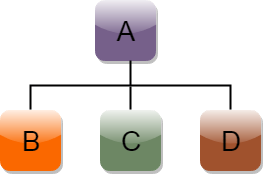Hierarchical inheritance is defined as the process of deriving more than one class from a base class.

Syntax of Hierarchical inheritance:
class A
{
// body of the class A.
}
class B : public A
{
// body of class B.
}
class C : public A
{
// body of class C.
}
class D : public A
{
// body of class D.
}
Let’s see a simple example:
#include <iostream>
using namespace std;
class Shape // Declaration of base class.
{
public:
int a;
int b;
void get_data(int n,int m)
{
a= n;
b = m;
}
};
class Rectangle : public Shape // inheriting Shape class
{
public:
int rect_area()
{
int result = a*b;
return result;
}
};
class Triangle : public Shape // inheriting Shape class
{
public:
int triangle_area()
{
float result = 0.5*a*b;
return result;
}
};
int main()
{
Rectangle r;
Triangle t;
int length,breadth,base,height;
std::cout << “Enter the length and breadth of a rectangle: ” << std::endl;
cin>>length>>breadth;
r.get_data(length,breadth);
int m = r.rect_area();
std::cout << “Area of the rectangle is : ” <<m<< std::endl;
std::cout << “Enter the base and height of the triangle: ” << std::endl;
cin>>base>>height;
t.get_data(base,height);
float n = t.triangle_area();
std::cout <<“Area of the triangle is : ” << n<<std::endl;
return 0;
}
Output:
Enter the length and breadth of a rectangle: 23 20 Area of the rectangle is : 460 Enter the base and height of the triangle: 2 5 Area of the triangle is : 5
